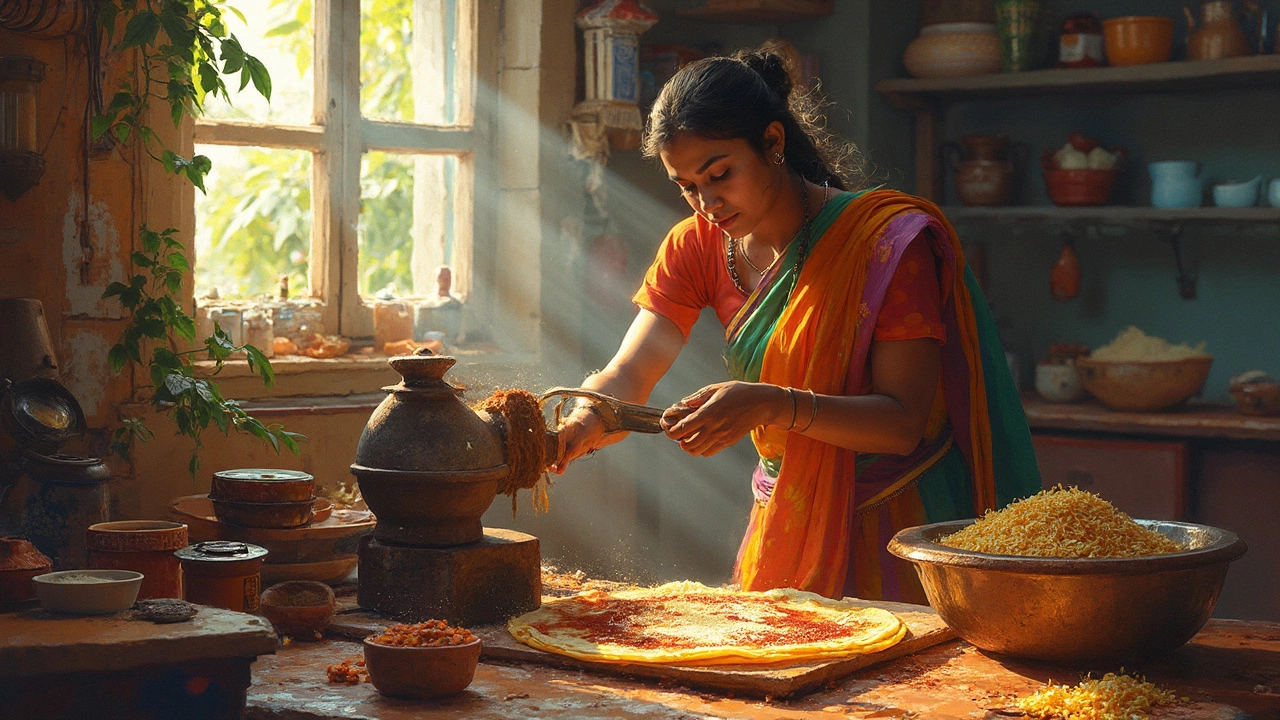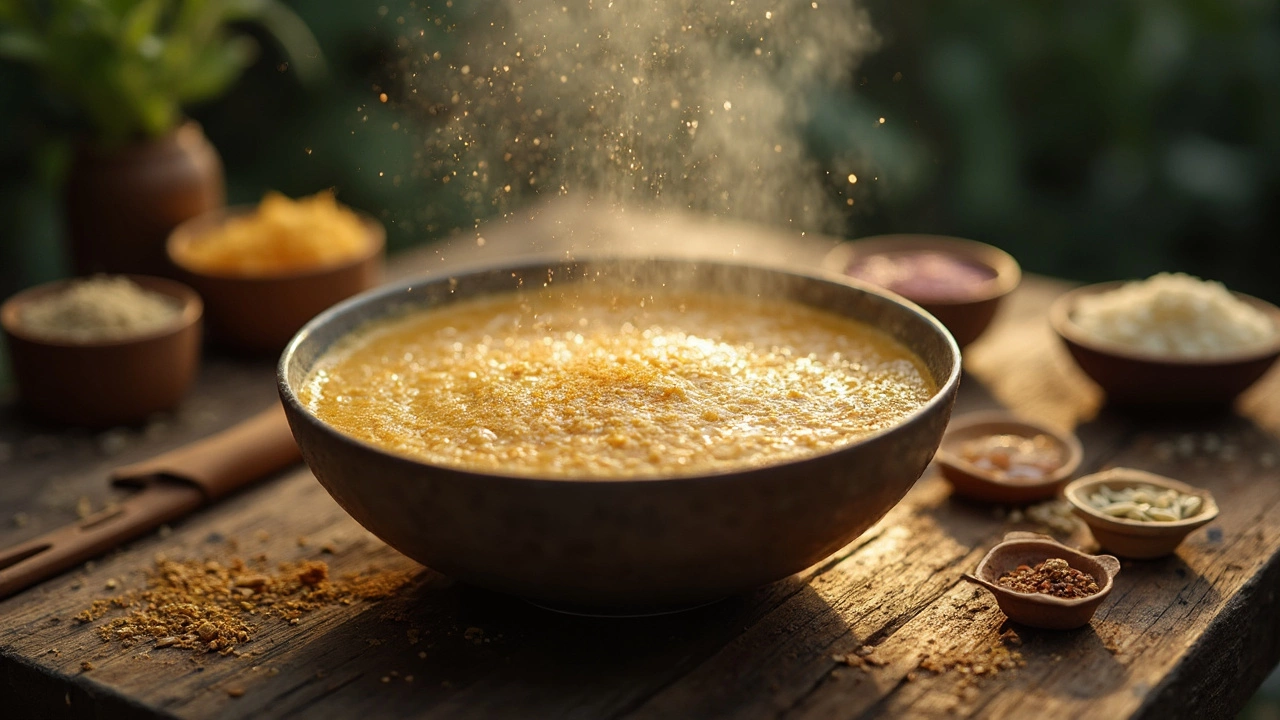Quick Methods to Get the Perfect Dosa Batter Without Yeast
 Feb, 13 2025
Feb, 13 2025
Who doesn't love a good dosa? It's that perfect combination of crispy, thin, and just the right tang. But, many people shy away from making dosa batter at home because they think it's complicated, especially without using yeast. Guess what? It doesn't have to be!
The magic of making dosa batter lies in getting your ingredients and their proportions just right. The classic combo? Rice and urad dal. But it's not just about throwing them together; how you soak, grind, and ferment makes all the difference.
So, how do you replace yeast to get that batter bubbling? Here's a tip: temperature is key. Keeping your batter warm can naturally aid fermentation. Placing it in a cozy spot or even swaddling the bowl with a warm cloth can work wonders.
Storing the batter is the next hurdle. Nobody wants their hard work going to waste. So, refrigerate it once it's fermented to keep it fresh for days. And if you've ever wondered why your dosas aren't as crispy as you'd like, it might just be the consistency. A batter that's too thick won't spread well on the griddle.
- The Basics of Dosa Batter
- Ingredients and Ratios
- Fermentation Tricks without Yeast
- Storing and Preserving Batter
- Troubleshooting Common Issues
The Basics of Dosa Batter
Thinking of making dosa batter at home? It's simpler than you might think! The primary ingredients are rice and urad dal, which is split black gram. The usual ratio is about 3 parts rice to 1 part urad dal. This proportion gives you the right texture and crispiness on your dosas.
Soaking: The First Step
Start by washing both rice and urad dal thoroughly. It's important to get rid of any surface starch to help with fermentation. Once that's done, soak them separately. The optimal soaking time is around 6 to 8 hours, so plan ahead. You can soak them overnight and begin your preparation the next morning.
Grinding: Getting the Right Consistency
After soaking, drain the water and grind the rice and urad dal separately as well. Why? Because urad dal needs to be ground finer than rice for that perfect aeration in your dosa batter. Add small amounts of water while grinding to get a smooth paste.
Don't worry if you don't have a fancy grinder; a good quality blender can do the job too. Just make sure the batter isn't too thick or too runny. It should be similar to pancake batter consistency.
Mixing and Fermenting
Combine the ground rice and urad dal. Now, here's a tip: A pinch of fenugreek seeds can be soaked and added to the batter to help in fermentation and flavor. Once mixed, let it sit in a warm place for about 12 to 24 hours.
Monitoring Fermentation
By the end of the fermentation period, your batter should have doubled in volume and have a slightly sour aroma. That's how you know it's ready. If you live in a cooler climate, you might need to give it a tad longer or put it in a slightly warm oven.
The science behind this is fascinating. The natural bacteria and yeast in the air work with the components in the batter to create that essential rise. No need for commercial yeast at all!
Ingredients and Ratios
When it comes to whipping up the perfect dosa batter, your ingredients and their proportions are everything. The classic dosa batter is known for using just two main ingredients: rice and urad dal (black gram lentils). But which rice to pick, and what's the magic ratio for that perfect texture?
Picking the Right Rice
Here's a secret: Not all rice works the same. Most dosa experts swear by using a mix of regular white rice and parboiled rice. Why? Parboiled rice adds that extra crispiness to dosas. Aim for a half-and-half mix of both types of rice.
Perfect Ratios Matter
Getting those ratios right is crucial. For a standard recipe, the widely accepted formula is:
- 3 cups of rice (a mix of regular and parboiled, if possible)
- 1 cup of urad dal
- A tablespoon of fenugreek seeds (optional, but adds flavor and aids fermentation)
Soak them separately for about 4-6 hours before grinding. This soaking is what helps blend them smoothly together later.
Grinding for Texture
The trick is to get a smooth yet slightly coarse texture. Use a wet grinder if you have one; it retains more of the batter's natural consistency. But no worries if you don't have one, a regular mixer grinder works fine too—just be patient and blend in batches.
Finally, mixing the ingredients might just be the most crucial step. Blend the urad dal to a fine paste and the rice to a gritty texture. Then, mix them together by hand, adding water gradually until you reach a batter consistency that's neither too runny nor too thick.
| Ingredient | Quantity |
|---|---|
| Rice (White + Parboiled) | 3 Cups |
| Urad Dal | 1 Cup |
| Fenugreek Seeds | 1 Tablespoon |
Once you've got the batter, let it ferment overnight in a warm place. This step is what brings that signature tangy taste to your dosas!

Fermentation Tricks without Yeast
Crafting the perfect dosa batter is all about fermentation, and you can definitely do it without yeast. It's a natural process, and when done right, it gives your dosa that distinctive flavor and texture we all love.
Understanding the Basics
The batter's magic happens when the rice and urad dal are combined and left to ferment. The natural bacteria present do the work, so creating the right environment for these tiny workers is key!
Temperature Is Your Friend
Fermentation speeds up in warmth. If you're in a cooler climate, you might need to provide some extra warmth to get things going. Here are a few tricks:
- Sunny Spot: Place your batter in a sunny location during the day.
- Warm Oven: Preheat your oven to the lowest setting, then turn it off and place the batter inside with the door slightly ajar.
- Swaddle Method: Wrap your container in a thick towel or use an insulated bag to retain room temperature heat.
Time Is of the Essence
The average fermentation time can vary between 8 to 12 hours. You know your batter's ready when you see bubbles on top and it has a slightly sour smell. If it hasn't fermented as expected, leaving it a bit longer usually does the trick.
Tips from the Pros
Seasoned cooks swear by using a little leftover batter as a starter for the next batch. This jump-starts the process because it's already full of active cultures.
If you're curious about numbers, some folks keep track of their fermentation success using a simple timeline or chart!
| Temperature (°C) | Fermentation Time (Hours) |
|---|---|
| 25 | 12 |
| 30 | 8 |
Every household has a slightly different approach, so don't be afraid to experiment and see what works best for you.
Remember, practice makes perfect. Once you get the hang of it, making dosa batter will feel like second nature, no yeast required!
Storing and Preserving Batter
So, you've made your perfect dosa batter, and now you're wondering how to store it without losing its magic touch. It's actually pretty straightforward once you nail the basic principles.
Firstly, after fermentation, it's crucial to pop that batter straight into the fridge. This halts the fermentation process, which is key to maintaining the right level of sourness. If left out too long, the batter can get too sour or even go bad, and nobody enjoys a sour surprise.
"Refrigeration maintains the batter's integrity without compromising on taste or texture." – Food Enthusiast Journal
Consistency is another thing to watch out for. Before shelving it in the fridge, make sure your batter is a tad thick. Once refrigerated, it tends to become thicker, so starting a bit ahead ensures it doesn't turn into a gloppy mess. And hey, if you need it to loosen later, just splash a bit of water and mix well before cooking.
If you plan on keeping the batter for more than a week, stir in a pinch of salt – this acts as a natural preservative. However, if you accidentally make too much batter, consider dividing it into portions. That way, you only pull out what you need without re-exposing the entire batch to varying temperatures.
Using Saved Dosa Batter Effectively
Don't limit yourself to just dosas. A well-fermented batter can double up for making idlis too – just keep the batter slightly thicker for that. Also, why not experiment a bit? Add some veggies or spices for a twist on the classic dosa.
Got too much batter leftover? Freeze it! Pour the batter into ice cube trays, freeze, and then store cubes in a ziplock. This way, you can just defrost what you need, when you need it.
Perfecting storing and preserving techniques can extend your batter's life significantly. With a little care, your yeast-free dosa batter will stay ready whenever hunger strikes.

Troubleshooting Common Issues
Even seasoned cooks sometimes run into problems with their dosa batter. Let's tackle some common hiccups so you can nail that perfect dosa every time!
Fermentation Fails
If your batter isn't fermenting well, you might want to check the room temperature. Dosa batter loves warmth. If it's too cold, the fermentation process just lags. Pop the batter in your oven with the light on or wrap it in a blanket to keep it cozy.
Batter Consistency
If your batter is too thick, your dosa might end up more like a pancake. Add a bit of water, little by little, until it reaches the right consistency—almost like a runny pancake batter. On the flip side, if it's too thin, you'll struggle to spread it out, so just toss in a spoonful of rice flour.
Not Crispy Enough?
If the crispiness is eluding you, check how hot your pan is. You need it to be sizzling hot to get that perfect browning. Also, using a bit more oil around the edges can help achieve that golden, crunchy texture.
Sour or Bland Taste
If the taste isn’t quite right, take stock of how long you've left the batter to ferment. Too long, and you’ll end up with a sour mess. But too short, and you’ll hardly taste any fermentation. Aim for a sweet spot, usually around 8-12 hours.
Uneven Cooking
Uneven cooking is often just a sign of an uneven spread or inconsistent heat. Use a flat-bottomed ladle and start from the center, spiraling outwards. Also, let each side cook thoroughly before flipping.
Remember, practice makes perfect! Every kitchen has its own quirks, so tweak these tips to suit your environment and soon enough, you’ll be flipping those dosas like a pro.